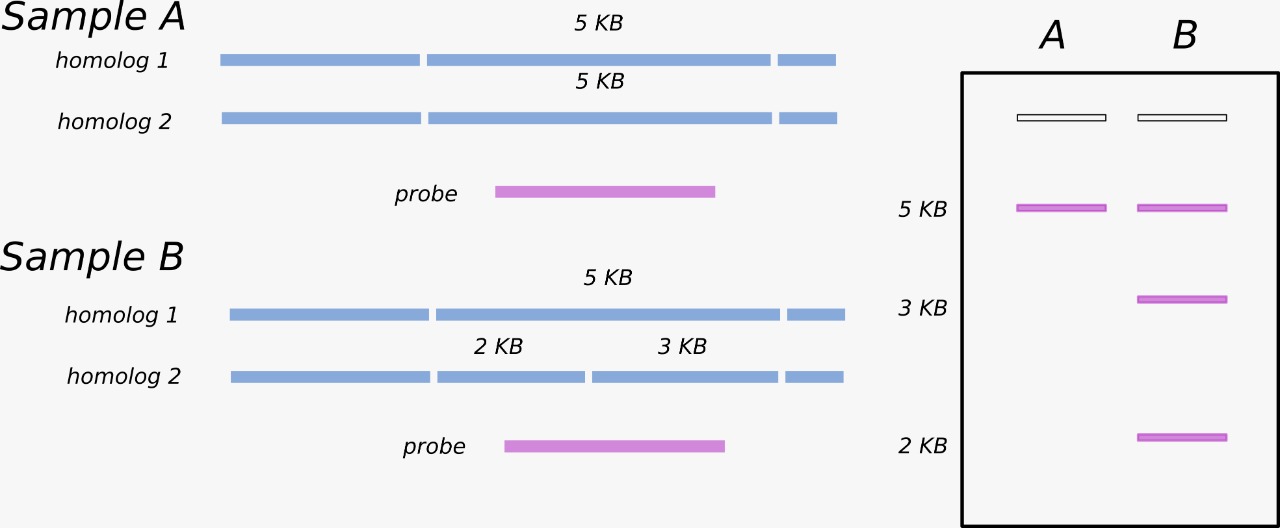DNA Fingerprinting
Genetic Uniformity: Nearly 99.9% of the human DNA sequence is identical. This raises the question of what makes each individual unique, considering the human genome is about 3 billion base pairs (bp).
Individual Differences: The answer lies in the 0.1% of DNA that differs among individuals. These genetic differences give rise to the unique traits and appearances of each person.
Challenges of Sequencing: If we wanted to identify these genetic differences by sequencing the entire DNA every time, it would be a challenging and expensive task. Comparing 3 million base pairs of DNA between individuals is not practical.
DNA Fingerprinting: DNA fingerprinting is a rapid and cost-effective method to compare the DNA sequences of two individuals. It identifies differences in specific regions of DNA called repetitive DNA.
Repetitive DNA: Repetitive DNA consists of small DNA segments that are repeated multiple times. They are separated from the bulk of genomic DNA by density gradient centrifugation.
Satellite DNA: Repetitive DNA is often referred to as satellite DNA, and it appears as distinct peaks during the centrifugation process. These sequences can be categorized based on base composition (A:T rich or G:C rich), segment length, and the number of repetitive units.
Polymorphism: These repetitive sequences do not code for proteins but exhibit high levels of polymorphism. Polymorphism means genetic variation among individuals.
DNA Fingerprinting Utility: DNA fingerprinting is invaluable in forensic applications. It can identify individuals from various tissue sources like blood, hair follicles, skin, bone, saliva, and sperm due to the consistent presence of polymorphism. Additionally, these polymorphisms are inheritable, making DNA fingerprinting essential in paternity testing during disputes.
Origin of Polymorphism: Polymorphism results from mutations, which can occur in an individual’s somatic cells or germ cells. Mutations in germ cells, if not detrimental to an individual’s reproductive ability, can spread throughout a population through sexual reproduction.
Allelic Variation: A locus with more than one variant (allele) in a human population with a frequency exceeding 0.01 is considered a DNA polymorphism. In essence, a hereditary mutation observed at a high frequency in a population is a DNA polymorphism.
Types of Polymorphisms: Polymorphisms vary in scale from single nucleotide changes to more extensive alterations. They play a significant role in evolution and speciation, topics you’ll explore in detail in advanced studies.
The technique of DNA Fingerprinting
Steps in the DNA Fingerprinting Process:
Sample Collection:
- Source of DNA: Start by collecting biological samples, which can include blood, hair, saliva, or any tissue that contains DNA. The quality and quantity of DNA can vary depending on the source.
Isolation of DNA:
- DNA Extraction: DNA is extracted from the collected samples using chemical methods. These methods break open cells and release the DNA.
DNA Digestion:
- Cutting the DNA: The extracted DNA is cut into smaller fragments using specific enzymes known as restriction endonucleases. These enzymes recognize and cut DNA at specific sequences.
Electrophoresis:
Separating Fragments: The cut DNA fragments are loaded onto a gel, and an electrical current is applied. This causes the fragments to move through the gel, with smaller fragments moving faster than larger ones.
Gel Electrophoresis: The resulting pattern of DNA fragments is visualized on the gel as distinct bands.
Southern Blotting:
- Transfer to a Membrane: After electrophoresis, the DNA fragments are transferred from the gel to a nylon or nitrocellulose membrane. This process is called Southern blotting.
Probing:
- Adding a DNA Probe: A DNA probe (VNTR), which is a single-stranded piece of DNA with a known sequence, is added to the membrane. The probe will bind to complementary DNA fragments on the membrane.
Hybridization:
- Binding of Probe: The DNA probe hybridizes (binds) to the complementary fragments on the membrane.
Autoradiography or Fluorescence:
- Detection: To visualize the DNA bands, the membrane is exposed to X-ray film in autoradiography or examined under UV light in fluorescence. This step creates a pattern of bands unique to the individual’s DNA.
Analysis:
- Interpreting the Pattern: The resulting pattern of bands is analyzed, and specific DNA fragments are compared between different individuals.
DNA Profile:
- Unique Pattern: Each individual has a unique DNA fingerprint based on the pattern of fragments. This profile can be used for identification purposes.
Applications
Forensics: DNA fingerprinting is widely used in criminal investigations to match suspects to crime scene evidence.
Paternity Testing: It’s used to establish biological relationships, such as determining paternity.
Genetic Research: DNA fingerprinting is valuable in genetic and medical research.
Importance
Reliable Identification: DNA fingerprints are highly reliable for individual identification because the probability of two individuals having identical DNA profiles is extremely low.
Justice and Accuracy: In criminal cases, DNA fingerprinting has played a critical role in establishing both guilt and innocence, leading to greater accuracy in the justice system.
Ethical Considerations: While DNA fingerprinting is a powerful tool, its use raises ethical considerations, such as privacy and consent, which need to be carefully managed.


